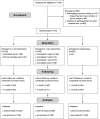Linking smokers to a quitline: randomized controlled effectiveness trial of a support person intervention that targets non-smokers
- PMID: 28854569
- PMCID: PMC5914310
- DOI: 10.1093/her/cyx050
Linking smokers to a quitline: randomized controlled effectiveness trial of a support person intervention that targets non-smokers
Abstract
Evidence-based treatments (e.g. quitlines) are greatly underutilized by smokers limiting their public health impact. A three-session phone intervention for nonsmoking family members and friends (i.e. support persons) was successful for increasing smoker quitline enrollment. To enhance the intervention's potential translatability, in this study, we delivered treatment for the non-smoker within ongoing quitline services and compared the efficacy of the three-call intervention to a streamlined version (one call). A total of 704 adult non-smokers (85% female, 95% White) wanting to help a smoker quit and recruited statewide in Minnesota participated in this randomized controlled trial with parallel groups. Non-smokers received mailed written materials and were randomly assigned to a control condition (no additional treatment, n = 235), or to a one- (n = 233) or three-call (n = 236) intervention delivered by quitline coaches. The main outcome was smoker quitline enrollment through 7-month follow-up. Smoker quitline enrollment was similar for those linked to non-smokers in the one- and three-call interventions (14.6% [34/233] and 14.8% [35/236]), and higher than for smokers linked to control participants (6.4% [15/235]), P = 0.006. Just one quitline coaching call delivered to non-smokers increased treatment enrollment among smokers. The reach of quitlines could be enhanced by targeting the social support network of smokers.
Trial registration: ClinicalTrials.gov NCT01331226.
© The Author 2017. Published by Oxford University Press.
References
-
- Jamal A, Homa DM, O’Connor E. et al. Current cigarette smoking among adults - United States, 2005-2014. MMWR Morb Mortal Wkly Rep 2015; 64:1233–40. - PubMed
-
- U.S. Department of Health and Human Services. The Health Consequences of Smoking: 50 Years of Progress. A Report of the Surgeon General. Atlanta, GA: U.S. Department of Health and Human Services, Centers for Disease Control and Prevention, National Center for Chronic Disease Prevention and Health Promotion, Office on Smoking and Health, 2014. Printed with corrections, January 2014. Available at: http://www.surgeongeneral.gov/library/reports/50-years-of-progress/full-.... Accessed: 1 July 2016.
-
- Cokkinides VE, Ward E, Jemal A. et al. Under-use of smoking-cessation treatments: results from the National Health Interview Survey, 2000. Am J Prev Med 2005; 28:119–22. - PubMed
-
- Shiffman S, Brockwell SE, Pillitteri JL. et al. Use of smoking-cessation treatments in the United States. Am J Prev Med 2008; 34:102–11. - PubMed
-
- Zhu S, Melcer T, Sun J. et al. Smoking cessation with and without assistance: a population-based analysis. Am J Prev Med 2000; 18:305–11. - PubMed
Publication types
MeSH terms
Associated data
LinkOut - more resources
Full Text Sources
Other Literature Sources
Medical
Miscellaneous


